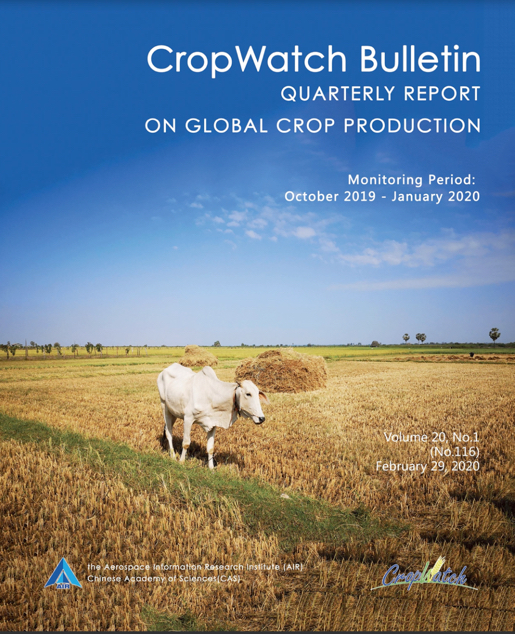
News
CropWatch Bulletin Releases Crop Production Outlook under the Shadow of Locusts
The latest issue of CropWatch Bulletin, a quarterly report published by the CropWatch research team from the Aerospace Information Research Institute (AIR), the Chinese Academy of Sciences (CAS) was released on February 29 to provide comprehensive description on world-wide crop conditions between October 2019 and January 2020, and insights on the crop production outlook for 2020.
Based on Big Earth Data, the report is jointly prepared on CropWatch Cloud Platform by an international team with 48 analysts from 11 countries coordinated by the Chinese Academy of Sciences.
The 209-page report covers prevailing agro-climatic patterns at global, continental, national and sub-national scales, crop and environmental conditions in major production zones in all continents, 42 core countries that together produce and commercialize 80 percent of maize, rice, wheat and soybean, as well as an individual analysis on China. In addition, the report also sheds light on the impact of disaster events on crop production of the inflicted regions.
The production outlook focuses on the major cereal and oil crops (maize, rice, wheat and soybean) countries in the southern Hemisphere and some tropical and sub-tropical countries. The assessment is based mainly on remotely sensed data.
The reporting period is characterized by extreme weather conditions, such as reportedly-highest temperature for January, heavy rainfall in many parts of Africa and the consequent floods, coupled with as frequent disaster events such as Australian fires, and worst of all, severe outbreak of Desert Locust, which has expanded from Arabian Peninsula into western Asia, East Africa, South-Asia and brought looming threat to China.
Despite the unfavorable conditions, the report assesses that, by the end of January 2020, the impact of the Desert locust on cereal production in Horn of Africa and South-Asia is limited, while locusts damaged rangeland and orchards and threated the livestock over those regions.
Pastures in Somalia were damaged by desert locusts, which threats livestock. The report assesses the greenness of rangelands in Bay and Jubbada Dhexe drop by 9.2% and 4.1% respectively in late November when locusts passed through. In Kenya, the most severely damaged rangelands were observed in Turkana and Wajir in the north. According to the report, “If locusts further spread to southern directly, they will also threat maize production during short rainy season.”
With respect to India and Pakistan, both affected by desert locusts in the second half of 2019, the wheat production in both countries “increased by 4%”, according to the report. The locust impact was concentrated in the Rajasthan of India and the northern part of Sindh province in Pakistan, which are not “major wheat producing areas” in both countries, the report adds. However, “substantial losses” on pasture in Nawabshah and orchards in Hyderabad, Tando Allahyar, Matiari, and Mirpurkhas of Pakistan were observed, says the report.
The full report is available by visiting CropWatch online at www.cropwatch.com.cn, http://cloud.cropwatch.com.cn/




